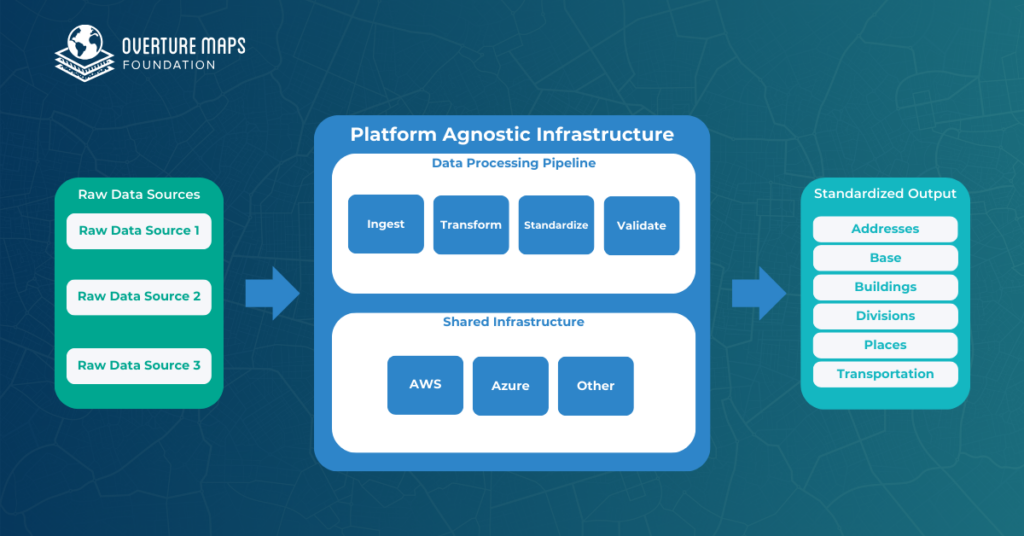
At Overture Maps Foundation, collaboration is at the heart of everything we do. While our data releases and Explorer tool represent visible progress, there’s an equally important effort happening behind the scenes: transitioning the data pipelines from member companies to Overture’s platform-agnostic infrastructure. This isn’t just a technical migration — it represents a profound commitment from our members to make Overture their foundational mapping infrastructure. This shift marks a significant milestone in our mission of creating open, scalable map data, demonstrating the deep trust our members place in Overture’s collaborative approach.
The Journey to Platform-Agnostic Infrastructure
When Overture began, our primary focus was getting data out to the community quickly. Member companies processed mapping data using their existing internal pipelines. While this approach helped us launch and begin delivering value, we knew it wouldn’t scale to support our long-term vision. As Eric Godwin, Principal Engineer at Overture explains, “Each company was reinventing the wheel, processing basic data that had become a commodity within the map space. It wasn’t a differentiator for their products, yet everyone had to do it.”
The realization was clear: to truly fulfill Overture’s mission of creating reliable, easy-to-use, and interoperable open map data, we needed to move beyond individual company pipelines to a shared infrastructure that could run anywhere. This shift would ensure that Overture’s workflows are not tied to any single member or cloud provider, making it easier for new contributors to join and collaborate and ensuring the sustainability of the project.
Breaking Down the Silos
Transitioning to platform-agnostic infrastructure means that instead of member companies processing data internally and providing the final output, member companies now contribute their raw data to be processed through Overture’s shared infrastructure.
This transformation brings several immediate benefits:
- Enhanced Collaboration: Engineers from different companies can now work together on the same codebase, sharing expertise and solutions. For example, in recent Places pipeline development, engineers from Microsoft, Meta, Tripadvisor, and other companies actively collaborated on solving complex challenges such as feature matching.
- Improved Transparency: With centralized processing, it’s easier for members to contribute and improve the data processing pipeline.
- Reduced Redundancy: Instead of maintaining similar data processing pipelines at each member company, we can complete the work once in a shared environment, eliminating duplicate efforts and allowing companies to focus on unique value-adds.
- Greater Flexibility: The infrastructure is designed to run on any major cloud platform, making it accessible to all members regardless of their preferred technology stack.
- Faster Integration: We can add new data sources more efficiently as the processing pipeline is standardized and accessible.
As Eric notes, “The beauty of bringing it to a shared location is that when you’re doing validation and correction, like the normalization of a name, we can solve the problem once and apply it to all aspects of our pipeline in a much easier way.”
Building the Foundation
The transition process is a massive collaborative effort. Each theme (e.g., Places, Buildings, Addresses) has its own pipeline for processing data, often involving multiple steps. Previously, Overture received only the final processed data from members. Now, we’re moving upstream to handle raw data directly within Overture’s infrastructure. This allows Overture to process and integrate the data consistently while creating opportunities for other members to contribute enhancements or address issues collaboratively.
To make this vision a reality, the technical team focused on several key areas:
- Tech Stack Standardization: The team selected open source tools such as Scala and Python for programming, Spark for distributed computing, Sedona for spatial processing, GeoParquet for data storage, and LakeFS for version control among others, ensuring they work seamlessly across platforms. This standardization promotes interoperability and makes it easier for contributors to adopt and use the infrastructure.
- Separation of Business Logic and Compute: By decoupling core data-processing logic from platform-specific configurations, the same logic can run consistently across different cloud environments. This reduces duplication and simplifies maintenance.
- Shared Data Stores: Data is stored at key stages of processing in a common repository. This standardization allows for easier validation, rollback, and integration across themes.
- Collaboration Across Teams: Member companies are actively contributing to the migration process, from providing resources to aligning on technical decisions.
Where Are We in the Process?
As of now, Overture has successfully migrated two-thirds of the data pipelines to our own infrastructure, with themes including Buildings, Base, and Addresses already running on the new system. Transportation is a complex pipeline that requires a significant lift to transition fully, but we’re getting there.
This progress represents more than just a technical achievement. It demonstrates the commitment of member companies to work together for the greater good of the mapping community. As Eric observes, “Members are showing real respect for each other here — accepting short-term velocity trade-offs for the greater benefit of the group.”
While progress has been steady, aligning multiple stakeholders, tools, and workflows has been a positive challenge. The result is a shared vision that reflects the diverse strengths of Overture’s members.
Looking Ahead
The future of this initiative focuses on scaling and automation. The team aims to build robust validation and metrics systems that will allow for faster data ingestion and processing. “I envision a world where we should be able to ingest, validate, and release a new data set in a couple of days,” says Eric, highlighting how this infrastructure will dramatically accelerate Overture’s ability to integrate and deliver new data.
A Model for Open Collaboration
This effort demonstrates what’s possible when organizations come together to solve shared challenges. It reflects the core of Overture’s mission: building open, reusable infrastructure to enable the best maps — not for one organization but for everyone.
We’re honored by the profound trust our members have placed in us and their willingness to make Overture their foundational mapping infrastructure. We’re proud of this milestone and excited about what’s next. The message is simple:
|
1 |
<b><i>We’re doing it, and we’re doing it together!</i></b> |
At Overture, we believe that collaboration is key to transforming the geospatial landscape. If you’re interested in joining our growing community:
- Get involved: Visit the Overture Maps Foundation website to learn more about our work, and join our community by becoming a member.
- Stay connected: follow us on LinkedIn, X, and Bluesky for the latest updates. Sign up for Overture’s monthly newsletter to receive exclusive updates on our technical progress and community initiatives.
